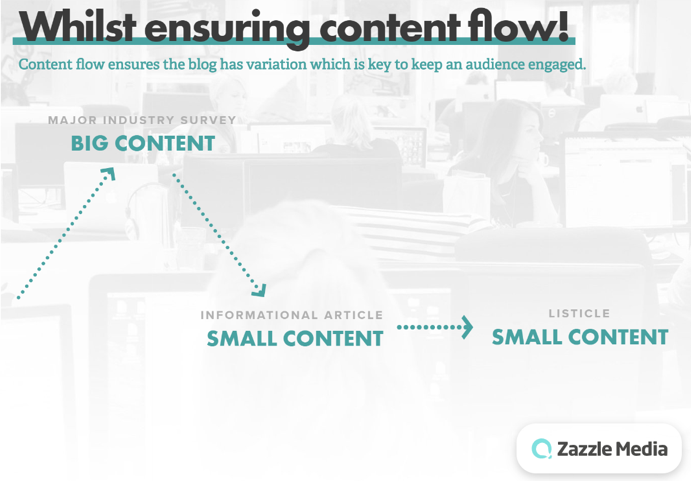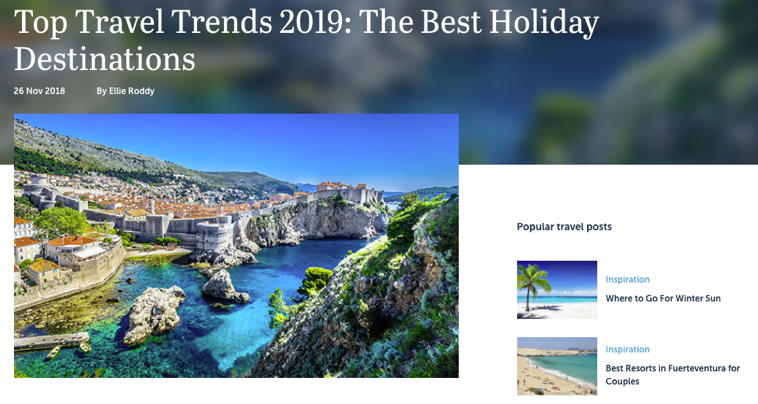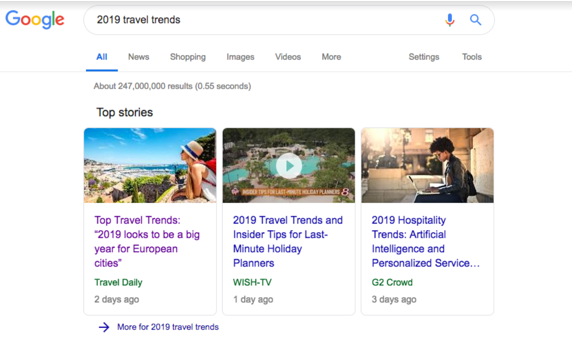There’s nothing more compelling than losing yourself in number crunching for hours and finding heaps of opportunity for clients. But, as painful as it is to say, there’s only so far numbers and cold hard data can get you.
Here at Zazzle Media we believe in Brand as Publisher, a principle which is about engaging your audience and growing your organic footprint through content. Whether that’s smaller blog pieces or huge campaigns - all pieces are relevant and everything serves a purpose.
We often ask people to think of a magazine. In this, you’ll see a whole array of content to keep you engaged and you don’t see page after page of the same type of content. There may be a few short pieces to get you gripped and then a double page spread to give you something serious to delve into, then back down to a few lighter pieces after that for variety. Applying this to your content ensures a healthy flow.

A big part of ensuring good content flow online is ensuring you have a solid content strategy, which not only targets high search driven content, but also engages users that are already there with more ‘human interest’ stories, articles you know your audience want and engage with.
If you’re thinking ‘that’s easy, I’ll create content I know my users want because I know my audience better than anyone!’, it’s worth noting that it’s not necessarily as simple as that.
Data insight is vital here to understand how users are acting on your site and how and where users are finding information from elsewhere online. What kind of sites? What structure? A listicle? Video? Here is where the balancing act comes in, you’ve got a whole heap of data on exactly where your users are when they are online, and you know their interests and useful sector information. So, how do you combine them into the best content strategy ever?
The creative way
Old school creatives will tell you that there’s nothing better than getting a load of heads together in a room and brainstorming ideas. This can get the creative fire burning.
Brainstorming is still such an important part of any content creation conversation, especially your big bang PR ideas that need that human-interest element. At Zazzle Media, we send all our ideas through a rigorous validation process, as it’s very easy to get caught up in a brainstorm with ideas that sound great when everyone’s feeding off the energy in the room but don’t stand up to scrutiny in the cold light of day.
The validation process is all about ensuring the ideas have a ‘hook’ - that special something which will excite, educate and interest audiences. Whether you want to attract links or gain brand awareness you need to have a ‘hook’.
The main drawback of solely using this approach is that ideas are inherently subjective, based around opinion and personal feelings towards what those people find ‘interesting’. That alone doesn’t necessarily translate into organic performance or broad audience engagement, if people don’t ‘get it’ your idea won’t go far.
The data way
Data on the other hand can really focus on some of the main drawbacks of ‘the creative way’. Data is more objective and tangible, if your ideas are supported by data you have a much bigger opportunity to say to managers ‘this is going to work’.
There’s so much data you can pull these days on various different topics - anything from where your audience is browsing online to how much time they spend online each day. For any content strategy we always start with informational keyword research (which we cover off in this blog). This enables us to have a good view of what questions users are asking around a certain topic, and allows us to prioritise answering these questions based on a number of factors.
Informational keyword research is the most obvious tool to be able to justify creating blog posts with the aim of attracting organic traffic - there are concrete amounts of searches per month of people asking the question that you can answer. However, there’s more to content strategy than blog posts.
When working on a content strategy we also run data around audience and demographic data, which allows us not only to understand what they’re asking but also how they would like to receive the answer and what they most likely to engage with. This way we can specifically tailor the content to appeal to the audience.
Data is also a great tool to use when trying to convince potential stakeholders or clients of investment in an idea. Showing them ‘the method behind the madness’ ensures they understand why you’re doing this. The major drawback of ‘the data way’ is that by using pure data, numbers and statistics, you can lose that creative flair that really engages users on a human level - that element which gives the idea the potential to go viral!
The middle ground
So, how do we make our content ideas so engaging on a human level, that there’s potential to go viral and get organically shared, but also search driven and data led to organically rank and capture traffic through the SERP? We find the middle ground.
We want both the data and creative ways to work together hand-in-hand, playing to each other’s strengths and picking up the slack where their counterpart isn’t as strong. Obviously, the ideal situation that we all strive for are perfect pieces of content that are strongly search focused, but also interesting and light enough to spark conversations and encourage friends to share them. Not only can finding the middle ground be excellent for brand exposure and traffic it can also help with your budget. Initially you might choose to put some paid behind the piece to get lift off but, ideally, this content should be picked up organically - meaning your distribution is taken care of by your audience.
The middle isn’t the middle
Finding the middle sounds relatively easy - you just need to find an idea that has data behind it and search opportunity as well as being interesting. But sometimes you have to use a bit of initiative. As touched on already, as using too much of one of the approaches can lead you down a dead end.
For example, if your business is a supermarket you have a much broader target audience and demographic than a medical supply chain. Don’t feel that you can’t do fun and shareable content for niche brands - you just need to think carefully to ensure that this is right for your market. With niche brands it may be that you have to rely on the data more to give you a steer into what people are asking, and the creative part can take a back seat until you’ve really drilled down into it. Whereas with a more lifestyle type, the creative side can maybe take the lead a little more, with guidance and support from the data.
Things can get complicated. The ‘middle way’ doesn’t always lie right down the middle and, depending on an array of factors and circumstances, you have to use bits from both tactics to achieve a strong content strategy that targets all areas and ticks all the boxes.
Performance
The most important part of any content is how well it does. It’s great being able to all huddle around and pat each other on the back saying how well everyone worked together, but if it hasn’t transformed into traffic and hard stats, it’s not gone well.
With content, it’s not always as cut and dried as organic figures or conversion rate, if your content is a big bang piece intended for brand awareness it can be tough to measure - it’s difficult but not always impossible.
Branded search increasing can be a sign that brand awareness is working, for example. Stuart Shaw, our head of search and strategy, wrote a good piece on establishing your brand traffic, which you can find here. It may not be easy to monitor big bang ideas but there is a way, and it’s really important to utilise brand mentions and branded traffic as an indicator of success.
Data and creativity as one
A campaign we worked with Broadway travel on recently offers a great example of merging together the data and creative approaches. We ran a lot of data behind the scenes to determine and project where the biggest holiday locations will be in the coming year. Broadway’s travel trends piece utilised interactive graphs to visualise what the most popular destinations will be in 2019.
This gained good traction almost instantly.
- It had more than 8,000 impressions in the first two months
- Was picked up organically by Travel Daily and featured on their site, which receives more than 21,000 organic visits a month
- Has started to rank for some highly competitive terms, travel trends (200 searches a month), the best holiday destinations (150), beautiful holiday destinations (400)
- Ranks on the first page for ‘holiday trends’.
This piece is a great example of the two strands working together. It contains interesting and useful analysis for readers, built on the foundation of mountains of data. It also captured a featured snippet.


Let’s bring it all together
Content is one of the most important elements required to perform well organically. This is why having a well thought out content strategy is really important when it comes to digital marketing - the two polar opposites of data and creative have often fought against each other so it’s time to break down the walls and work collaboratively.
Just because a content idea is born from search volume and estimated incremental traffic doesn’t mean it has to be drab. Actively get your creative team involved and spruce it up a bit. Similarly, just because an idea has come from four people brainstorming in a room doesn’t mean it can’t have an organic benefit, get the data guys involved and see what they can find. Often if it’s a good idea it just needs tweaking to target some valuable terms.
You’re all working towards the same goal, it doesn’t have to be you vs them. Realistically, the quicker creative and data work together the quicker you win big - and that’s something we all want.
Sign up for our monthly newsletter and follow us on social media for the latest news.





 Proudly part of IPG Mediabrands
Proudly part of IPG Mediabrands